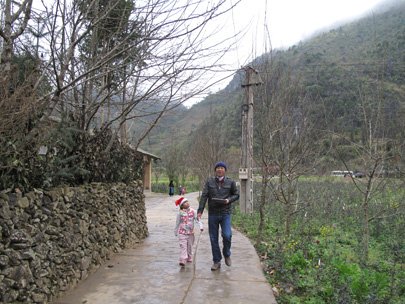It seems a crazy notion to go to Ha Giang Province at this time of the year when the sunshine is absent and the whole mountainous region is blanked in mist, clouds and chill. However, walking among the clouds is an amazing experience that tourists and expatriates should consider.

A man takes his kid to the old wooden house which was featured on the movie ‘Life of Pao’ in Sung La Village - Photos: My Tran.
Ha Giang is a beautiful area close to the border with China, which is divided into three regions with rocky uplands to the north, with large slopes, valleys and many rivers and streams; the tropical climate with shaded areas divided into two seasons, rainy and dry, and to the west is highland mountains, rivers flowing upstream, steep slopes, high passes, narrow valleys and stream beds.
We came to Ha Giang on Boxing Day and the first impression was the icy cold northeast region, totally different from the scorching heat of Saigon. From Ho Chi Minh Square in the center of Ha Giang Province, we started on the Hanh Phuc (Happy) Road to conquer the tortuous sloping road. Surrounded by mist, we could see objects in detail from a distance of about five meters. However, clusters of clouds skimming over the roads, hovering on mountain peaks and playing on tribes of ethnic people in the valley made us feel we were looking at winter scenery of Europe.
The first stop was Quan Ba Heaven Gate and reaching the gate, the mist enveloped us, with the biting breeze rushing into the bus as soon as the door was opened. But we were keen to walk out and yelled ‘Here we are, heaven’s gate is here and we’re gonna go to heaven.” Heaven’s Gate is about 1,500m above sea level, and in 1939, the French built a stone wall and a wooden gate to block the pass, in order to prevent access to the Dong Van plateau and beyond. From the top of the mountain pass, we looked down across a large valley of unending terraced fields, displaying a charming beauty like a paradise dimly visible through the clouds.
The next thrilling bus stop was Lung Cu. By this time it was about 5 p.m. but the dark had overwhelmed us. Without fear of getting lost in darkness, with the chill and mountains around us, we trekked up to touch the flagpole to much excitement and joy. Accompanying us was a guide, who told us that the flag tower itself stands proudly 1,600m above sea level. Its design is an imitation of the Hanoi Flag Tower, with eight bronze drums guarding the sides of the octagonal tower. The national flag adorning the top of the 135-stair tower has an area of 54 square meters, symbolizing the unity of Vietnam’s 54 ethnic groups.
It was back to Dong Van Ancient Town for sleep and we had the whole next morning to discover the ancient town which was formed and built in the early 20th century. Dong Van Town is nestled in a valley in the heart of the Rock Plateau of Dong Van. The town has a cluster of houses that line the street with one end leading to the road to Yen Minh Town and the other to the sublime beauty of Ma Pi Leng Pass and Meo Vac Town. Dong Van Town is surrounded by rock mountains which are grey all year round. The town has dozens of old houses which are about one hundred years old.
However, the feeling of walking among the clouds came to a climax when we reached Ma Pi Leng Pass, among the four highest peaks in Vietnam. The pass stretches about 20 kilometers or more along the sides of magnificently beautiful mountain ranges and runs along a section of the Nho Que River that weaves its way like a silver ribbon through the limestone ravines. The attraction of the Ma Pi Leng Pass lies in the mountains and cliff walls that the road passes.
Have you ever seen clouds fly under your feet? For me, at the height of 2,000 meters above sea level, that was the first time I had touched the sky and even now that dreamy scenery is still in my mind.
The northeast region has much tourism potential. Vietravel Company in collaboration with Vietnam Airlines are offering tours to explore the magnificent beauty of the region including Tuyen Quang, Ha Giang, Cao Bang, Bac Kan, Thai Nguyen and Lang Son provinces.